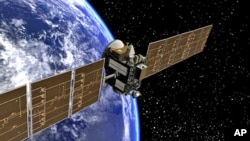An unmanned U.S. spacecraft named Dawn is heading toward a huge space rock, with a rendezvous expected on July 16. NASA scientists say they hope the unprecedented encounter in the asteroid belt will shed light on the history of the solar system.
Vesta is not just any asteroid. At 530 kilometers in diameter, it is the second most massive object in the asteroid belt - a vast region between Mars and Jupiter that is filled with rocky debris. Scientists call Vesta a "protoplanet" because it almost formed into a planet like Mars or Earth.
And now Vesta is getting a visitor - the Dawn spacecraft.
Robert Mase is the Dawn project manager at NASA's Jet Propulsion Laboratory in California. He spoke to reporters at a mission preview briefing late last month.
"After traveling for nearly four years, 1.7 billion miles [2.7 billion kilometers] and two laps around the Sun, Dawn is finally on our final approach to Vesta," Mase said.
And this week, as the rendezvous date approaches, Mase says Dawn is right on target.
NASA's Dawn spacecraft is expected to fall into orbit around Vesta on July 16. After Vesta captures Dawn in its orbit, engineers estimate they will be about 16,000 kilometers apart.
The spacecraft has sent back pictures of Vesta, and the images are far sharper than the ones taken by the Earth-orbiting Hubble Space Telescope. Researchers already are expressing surprise at the asteroid's extremely varied surface features. But the real science gathering is not even expected to begin until next month.
But how does a spacecraft get from the Earth to the asteroid belt? Dawn relies partially on solar energy. The spacecraft has two solar panels, totaling about 16 meters in length. Dawn's wingspan is about 20 meters, which NASA's Robert Mase says makes Dawn the largest interplanetary spacecraft the US space agency has ever launched. Plus, Dawn has three ion engines. That type of propulsion might be familiar to science fiction fans, as an alien spacecraft used it in the 1960s American television series "Star Trek."
Ion engines are efficient because they are powered by electrical fields, not chemical reactions.
Robert Mase says ion engines initially produce very low thrust. "About as much as a single piece of paper would push down on your hand. So this means we go from zero to 60 [miles per hour, or about 95 kilometers per hour] in about four days. But the ion engine can continue to thrust and accelerate, day after day, month after month, eventually achieving tremendous velocities over time," Mase said.
Dawn will spend a year orbiting Vesta - the first prolonged visit to a main belt asteroid. It will map the mineral composition and features of Vesta's surface, collect information about Vesta's gravity field and peer into a massive crater that might expose the asteroid's core.
Then Dawn will fire its engines and fly toward the dwarf planet Ceres - the largest object in the asteroid belt. It is expected to orbit Ceres in early 2015, and spend several months gathering data.
Mase says the Dawn mission is unusual because the spacecraft will rendezvous with not one, but two bodies in the solar system.
Researchers say Vesta is no stranger to Earth. Chunks of the protoplanet have been knocked off during collisions with other space rocks. Scientists theorize that perhaps five percent of the meteorites on Earth originated on Vesta.
US Spacecraft to Rendezvous with Asteroid










